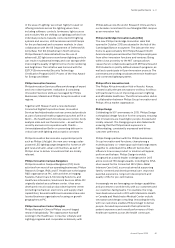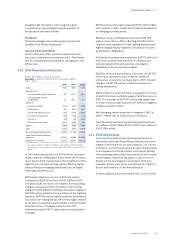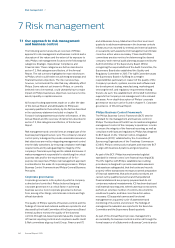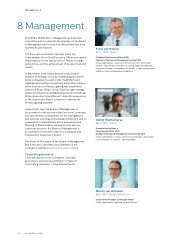Philips 2015 Annual Report Download - page 66
Download and view the complete annual report
Please find page 66 of the 2015 Philips annual report below. You can navigate through the pages in the report by either clicking on the pages listed below, or by using the keyword search tool below to find specific information within the annual report.
Risk management 7.2
66 Annual Report 2015
7.2 Risk categories and factors
Risks categories
Risks
Strategic
• Macroeconomic changes
• Changes in industry/market
• Growth of emerging
markets
• Joint ventures
• Acquisitions
• Intellectual property rights
Operational
• Transformation programs
• Innovation process
• Intellectual Property
• Supply chain
• IT
• People
• Product quality and liability
• Reputation
Compliance
• Legal
• Market practices
• Regulatory
• General Business Principles
• Internal controls
• Data privacy/Product
security
Financial
• Treasury
• Tax
• Pensions
• Accounting and reporting
Corporate Governance
Philips Business Control Framework
Philips General Business Principles
Taking risks is an inherent part of entrepreneurial behavior. A
structured risk management process allows management to
take risks in a controlled manner. In order to provide a
comprehensive view of Philips’ business activities, risks and
opportunities are identified in a structured way combining
elements of a top-down and bottom-up approach. Risks are
reported on a regular basis as part of the ‘Business
Performance Management’ process. All relevant risks and
opportunities are prioritized in terms of impact and
likelihood, considering quantitative and/or qualitative
aspects. The bottom-up identification and prioritization
process is supported by workshops with the respective
management at Business, Market and Group Function level.
During 2015, several risk management workshops were held.
The top-down element allows potential new risks and
opportunities to be discussed at management level and
included in the subsequent reporting process, if found to be
applicable. Reported risks and opportunities are analyzed for
potential cumulative effects and are aggregated at Business,
Market and Group level. In line with the above, amongst
others, the following actions were performed during 2015:
•
In 2015 the Supervisory Board established the Quality and
Regulatory Committee. The establishment of the Q&R
Committee further strengthens Philips’ risk management
efforts in respect of the quality of Philips’ products,
systems, services and software and the development,
testing, manufacturing, marketing and servicing thereof.
• As per February 2015, Philips acquired 100% of US-
based Volcano Corporation. Similarly, in the second
half of 2014 the Philips acquired 51% of Saudi-based
General Lighting Company (GLC). Philips successfully
integrated Volcano and GLC into the Philips Business
Control Framework in the course of 2015.
• As a next phase in the Accelerate! program, Philips
announced in 2014 its plan to establish two stand-
alone companies focused on the HealthTech and the
Lighting opportunities respectively. The separation
risk was described as from 2014 (refer to section 7.7,
Separation risk, of this Annual Report) and in 2015 we
have paid particular attention to risks related to the
separation as this is a very complex process.
•Philips had substantial dened benet pension plans
which carry nancial risk. During 2015 the Company
further de-risked pension exposure by means of
settling the Dutch, UK and (partly) US dened benet
pension plans.
•The challenging global economic developments had
an impact on our results. Even though the managing
of risks related to these developments did not change
compared to 2014, we continuously monitor the
impact on our risk prole.
Philips has a structured risk management process to address
different risk categories: Strategic, Operational, Compliance
and Financial risks.
Risk appetite is dierent for the
various risk categories:
• Strategic risks and opportunities may aect Philips’
strategic ambitions. Strategic risks include economic
and political developments and anticipating and
timely responding to market circumstances. Philips is
prepared to take considerable strategic risks given
the necessity to invest in research & development
and manage the portfolio of businesses, including
acquisitions and divestments, in a highly uncertain
global political and economic environment.
• Operational risks include adverse unexpected
developments resulting from internal processes,
people and systems, or from external events that are
linked to the actual running of each business
(examples are solution and product creation, and
supply chain management). Philips aims to minimize
downside risks due to the need for high quality of its
products and services, reliable IT systems and
sustainability commitments.
• Compliance risks cover unanticipated failures to
implement, or comply with, appropriate laws,
regulations, policies and procedures. Philips has a
zero tolerance policy towards non-compliance in
relation to breaches of its GBP.
• Within the area of Financial risks, Philips identies
risks related to Treasury, Accounting and reporting,
Pensions and Tax. Philips does not classify these risk
categories in order of importance. Separation risk is
























